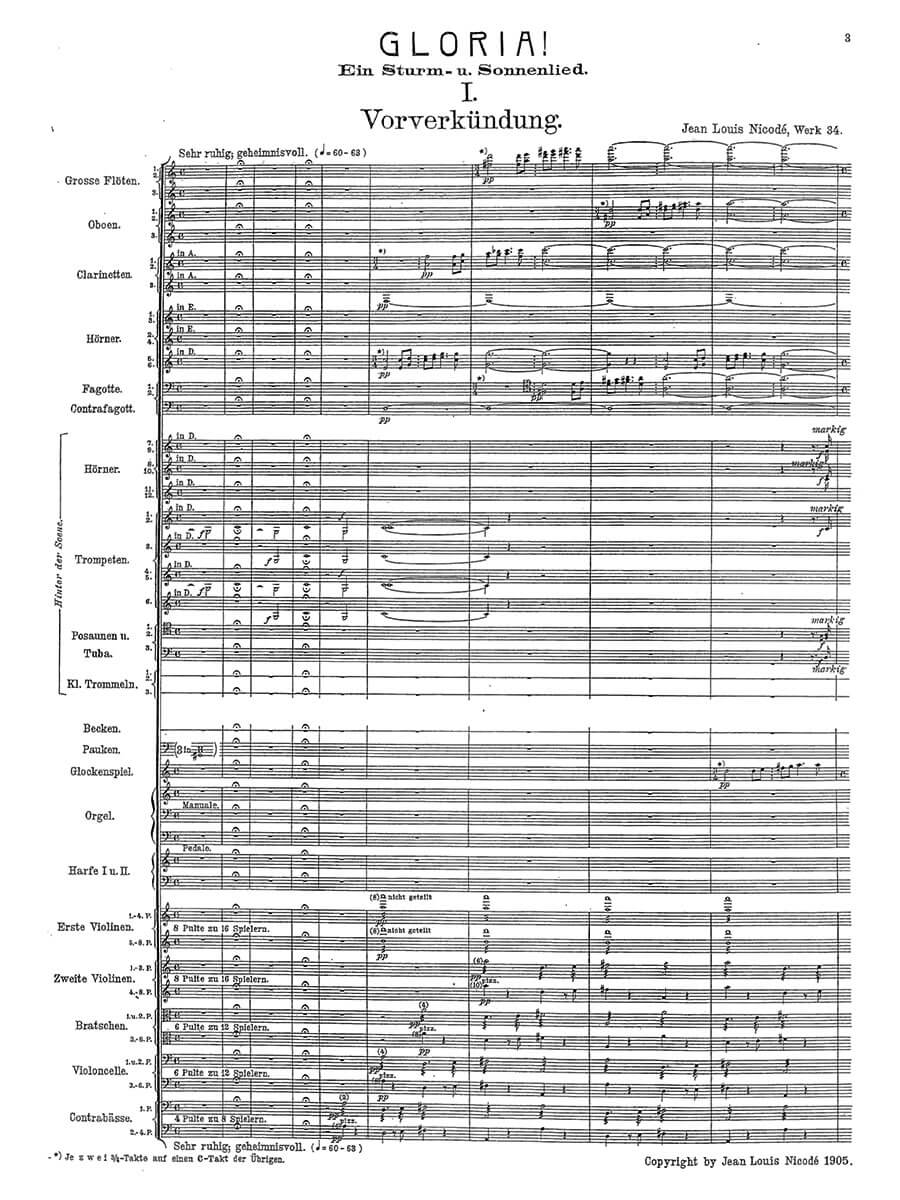Gloria! A Storm and Sun Hymn. Symphony in one movement Op. 34, for large orchestra, organ, and mixed final choir with contralto solo (with extra booklet including Nicodé’s additional introduction with text and musical examples)
Nicodé, Jean Louis
74,00 €
Preface
Jean Louis Nicodé – Gloria! A Storm and Sun Hymn. Symphony in one movement Op. 34
(b. Jezyce near Poznan [Jersitz near Posen], 12 August 1853 –
d. Langebrück [Dresden], 14 October 1919)
For large orchestra, organ, and mixed final choir with contralto solo (1902-04)
I Pre-Annunciation (p. 3) – Of Joy of Emergence and a thousand aims (p. 7)
II “Through the Fire.” Scherzo I (p. 51) – “Through the Forge.” Scherzo II (p. 69)
III A Sunny Day of Fortune (p. 103)
IV The Quietest Hour (p. 169)
V Toward the Supreme (p. 199)
VI The New Morning (p. 283)
Preface
Jean Louis Nicodé was one of the most significant German composers between Johannes Brahms and Richard Strauss. His father was of French-Huguenot, his mother of Polish descent. In the third year after his birth the family moved to Berlin after the father had lost his property “by misadventure“. First he got some music lessons by his father. Then was taught privately by the organist Hartkaes. In 1869 he began studying at the ’Neue Akademie der Tonkunst’ that had been founded by Theodor Kullak (1818-82) in 1855. Director Kullak was his piano teacher, the Mendelssohn pupil Richard Wüerst (1824-81) and later on Friedrich Kiel (1821-85) were his composition teachers. After finishing his academic training Nicodé first became well-known as a pianist, and in 1878 he was appointed piano teacher at the Royel Conservatory in Dresden one year after Franz Wüllner (1832-1902) had been appointed the institute’s director. In 1884 Wüllner became director of the Cologne Conservatory, and Nicodé followed him there after the Dresden directorate had prevented him from programming a four-hands arrangement of Franz Liszt’s ’Faust Symphony’. But then he was offered the direction of the Philharmonic Concerts in Dresden. He strongly supported the cause of the ’Neudeutsche’ (New-German school), met with massive hostility, and vacated his position in 1888. In 1893 he became musical director of the Chemnitzer Städtische Kapelle [Chemnitz Municipal Orchestra] and there he also founded a new choir in 1896 that soon became well-known as the ’Nicodé Choir’. In Dresden he staged the ’Nicodé Concerts’ until 1900 and established the music by Felix Draeseke, Anton Bruckner and Richard Strauss against all the conservative resistance. He mainly became legendary as a conductor of Beethoven and Wagner, demanded 22 rehearsals for Beethoven’s Missa solemnis, and Ferdinand Pfohl (1862-1949) described him as a “genius conductor by nature. In Nicodé’s art of conducting truely musical conception that penetrates to the last depths of the work of art merges with spirited and emotional interpretation that is stimulated by inner warmth and fiery temper, with clarity and plasticity: the full inward and outward correlation of the work of art.“
Gloria! Op. 34
In 1900 Nicodé, for years fiercely attacked by conservative critics, withdrew from conducting to Langebück in the Dresden Heath. There he finally devoted himself intensively to composition again and within three years – at the same time as a processing of his own fate – created his main work, the hugely scored symphonic tone poem lasting about two and a half hours without interruption ‘Gloria! Ein Sturm- und Sonnenlied’ for choir and orchestra op. 34. Nicodé’s most important works that preceded this enormous work were in 1884-88 the symphonic ode ‘Das Meer’ op. 31 for male choir, solo, large orchestra and organ after poems by Karl Woermann (1844-1933), and before that the Symphonic Variations op. 27, about which Ferdinand Pfohl wrote in 1902: “Nicodé’s harmony is bold and grand, his contrapuntal mastery imposing, his orchestration poetic, dramatic, and of special beauty and peculiarity of color.”
Almost 15 years had passed between the completion of the last preceding large work ’Das Meer’ and the beginning of ‘Gloria!’. In between, during more than a decade of intense conducting activity, only two smaller works were written: the 2 Stücke for String Orchestra, 2 Oboes and 2 Horns, Op. 32, and the hymn ‘Erbarmen’ for alto or mezzo-soprano and orchestra. …
Read full preface / Das ganze Vorwort lesen> HERE
Score Data
| Edition | Repertoire Explorer |
|---|---|
| Genre | Choir/Voice & Orchestra |
| Size | 225 x 320 mm |
| Specifics | with extra booklet including Nicode's additional introduction with text and music examples |
| Pages | 390 |
